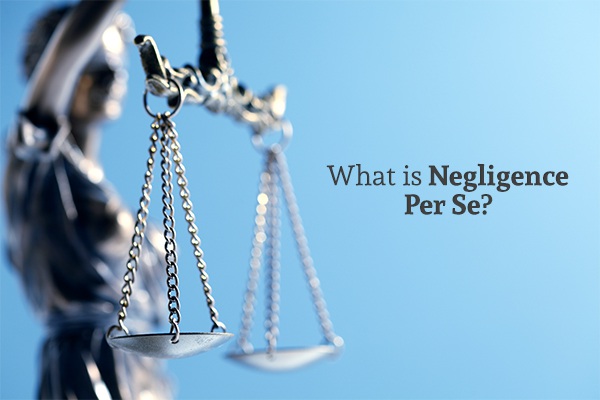
Table of contents
The most important element of most personal injury cases is proving negligence. To win, an injured party has to prove that their injuries were caused by the negligence of another. The law recognizes multiple types of negligence – one of which is known as negligence per se. Cases involving negligence per se are distinct in that the negligence doesn’t need to be proved. Here is a detailed overview of what negligence per se is and how it can potentially affect your personal injury case.
Introduction of Negligence Per Se
Negligence per se occurs when someone violates a law intended to protect others. Unlike other negligence cases, there is no need to compare the person’s actions to those a reasonable person would take because there’s proof that the defendant performed a criminal act. In these cases, the offender is automatically considered negligent, and the only thing that the crime victim needs to prove is that they were harmed as a direct result of negligence.
Negligence Per Se Vs. Standard Negligence
In standard negligence cases, a defendant’s actions are compared to that of a reasonable person. For example, if a property owner does not put down salt or remove ice from their sidewalks after an ice storm, they may be considered negligent. The belief is that a reasonable person would make sure their walkways are safe and passable for guests, even though there isn’t a law that requires them to do so.
In standard negligence cases, it has to be proven that the following elements were present in the plaintiff’s case to get the compensation they deserve for injuries and damages:
- The Defendant Owed the Plaintiff a Duty of Care: The defendant was legally obligated to act in a way that would avoid causing harm to the plaintiff. As with the example of the homeowner, they owe their guests a duty of care to ensure that their property is reasonably safe.
- Breach of Duty: The defendant breached their duty of care through action or inaction. As with our previous example, the homeowner did not clean off their sidewalks even though they knew the sidewalk was icy. This led to the sidewalk being dangerous for individuals who used it.
- The Breach of Duty Is What Caused the Plaintiff’s Injuries: The defendant’s action or inaction directly led to the accident which caused the plaintiff’s injuries. The plaintiff would not have sustained those injuries had the defendant not breached their duty of care. In the case with the icy sidewalk, had the defendant cleared off the sidewalk, the plaintiff wouldn’t have slipped and injured themselves.
- Damages: The defendant’s behavior caused the plaintiff to suffer losses or damages. The damages were a direct result of the injury sustained from the accident. Damages that can be compensated for include but are not limited to:
- Medical bills (present and future expenses)
- Lost wages
- Pain and suffering
- Loss of Future Earning Capacity
Negligence per se, on the other hand, asserts that the defendant is automatically negligent because they violated a statute or regulation enacted to protect a class. It was the violation of the statute that directly resulted in the plaintiff suffering harm. This establishes a presumption of negligence, allowing you to skip the first two elements of proof.
Legal Foundations of Negligence Per Se in Texas

Unlike a typical negligence case, negligence per se does not leave room for ambiguity among the judge or the jury. It is a clear yes-or-no question as to whether a law was violated. Unlike normal questions that are often asked of the jury or judge during a personal injury case, such as “Was the defendant, John Doe, negligent?” The questions are more factual, such as “Was the defendant, John Doe, speeding at the time of the accident?” This leaves little room for debate as the question being asked establishes a fact of what happened versus a personal opinion about whether the defendant should have known that their actions were negligent or reckless.
Examples of Negligence Per Se Cases
A wide variety of claims may fall under the negligence per se umbrella. These include:
- Injuries sustained in motor vehicle accidents caused by drunk driving, speeding, or another violation of traffic laws
- Injuries attributed to building code, health code, or safety code violations
- Death or harm caused by someone practicing medicine without a license
- Harm sustained as a result of being refused emergency medical care
- Work injuries because an employer failed to provide instruction/information about hazardous chemicals in the workplace
Applying Negligence Per Se on Personal Injury Claims
Ultimately, it is up to the court to determine whether or not a personal injury case will be classified as a negligence per se case. To establish this, the plaintiff must be able to show the following:
- That the defendant violated a law or a statute that exists for the safety of the public
- The statute violation resulted in an accident that caused the plaintiff’s injuries
- The action that the defendant took resulted in an accident and injury that the law was created to prevent
- The plaintiff is a member of the public and protected class for that particular law
The first two bullet points will be determined by either the judge or the jury to be undeniably factual. The judge will have to determine the last two bullet points, as they are a matter of law and not fact.
Does Negligence Per Se Carry Harsher Penalties Than a Traditional Negligence Case?
No. The penalties for both negligence and negligence per se will remain pretty much the same. The compensation given to the plaintiff will be determined by the facts of the case. However, the defendant may have to serve jail time or another penalty for breaking the law, but this is often handled outside of the personal injury case.
Hernandez Law Group, P.C. Insight: Actual Case Studies From Texas Law History
If you are interested in reading how real-life negligence per se cases were resolved in court, Texas history is full of them. Some of the more famous cases are as follows:
Defenses Against Negligence Per Se Claims

In most cases, it is hard to argue against a negligence per se claim as there is ample evidence that the defendant broke the law. For example, this evidence may come from camera footage of a dash-cam or eye-witness testimony, for accidents caused by running red lights or reckless driving. Individuals accused of driving under the influence can have their blood alcohol concentration test result as evidence used against them or the police report filed by the responding police officers.
However, there are certain scenarios where the defendant may have violated a regulation involuntarily due to conditions or situations outside of their control. The defendant may try to prove the following:
- They were incapacitated during the time of the violation: they had a medical emergency at the time of the violation that made them unable to respond, such as a seizure.
- The defendant was unaware of the law: this often happens with drivers who are from another state or country. However, in this case, the defendant must show that they could not have reasonably known about the statute for this defense to work. Ignorance is never a valid excuse.
- The defendant was unable to comply with the law even when using reasonable care: perhaps this was because the defendant was given the wrong medicine due to a pharmacy mix-up, which led them to be loopy while on the road. Or perhaps there was a mechanical issue with the car which caused them to be unable to determine their speed or brake in time for the light.
- It was more dangerous to comply with the law compared to breaking it: These cases can be hard to prove. The defendant would have to show that, for example, breaking the law, such as merging into another lane without using their turn signal or checking to see if there was a car next to them, would have been better than following procedure. These cases are often a result of another individual breaking the law. For example, if a driver was driving down the interstate and noticed that an 18-wheeler was barreling at them, unable to stop, and they decided to merge without looking into the other lane which resulted in an accident. The accident with the 18-wheeler could have been more fatal than the sideswipe accident that occurred as a result of the defendant’s actions.
The Role of a Personal Injury Lawyer in Negligence Per Se Cases
Negligence per se greatly increases an individual’s chances of getting the compensation they deserve during a personal injury case as the burden to prove negligence is no longer placed on the plaintiff. They just have to be able to show that the defendant broke the law and it was the breaking of this law that led to their injuries.
A personal injury attorney, such as the Hernandez Law Group, can help you establish this by investigating the case, gathering ample evidence to show the jurors and judge the infraction, and ensuring that you get the compensation you deserve. The personal injury attorneys at the Hernandez Law Group, P.C. have years of experience helping individuals get their lives back on track after an accident. We have years of experience handling all types of negligence cases, from gross negligence to negligence per se. Contact our attorneys today to get started with a free no-obligation consultation.
